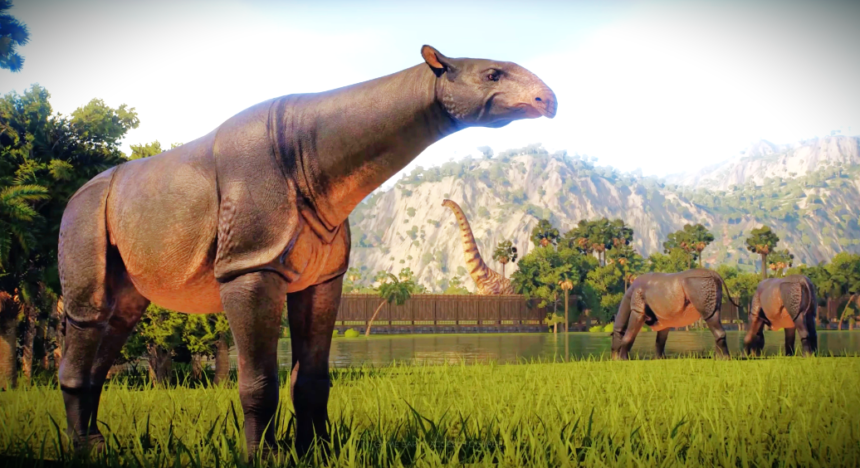Baluchitherium, also known as Paraceratherium, was one of the largest land mammals to have ever walked the Earth. This colossal herbivore, which roamed the vast plains of Asia during the Oligocene epoch, is a subject of fascination for paleontologists and enthusiasts alike. Understanding its size, behavior, and ecological significance provides us with a unique glimpse into the world of prehistoric giants.
The Discovery and Naming of Baluchitherium
Baluchitherium was first discovered in the early 20th century by British paleontologist Sir Clive Forster Cooper in the Baluchistan region of present-day Pakistan, from which its name is derived. The genus name Paraceratherium, which is more scientifically accepted, reflects its close relationship with modern rhinoceroses. Despite its massive size, this mammal is not as well-known as other prehistoric giants, such as the woolly mammoth or the saber-toothed tiger, but its discovery has been crucial in understanding the evolution of large mammals.
Physical Characteristics: A Giant Among Giants
Baluchitherium stood out for its incredible size. Estimates suggest that it could reach up to 18 feet in height at the shoulder and weigh as much as 20 tons. To put this into perspective, Baluchi therium was roughly twice the height of a modern African elephant and could weigh as much as four times more. Its long neck and legs allowed it to browse from the tops of trees, much like today’s giraffes, but on a far grander scale.
The skull of Baluchitherium was relatively small compared to its body, yet it housed strong teeth adapted for chewing tough vegetation. Its limbs were robust and columnar, capable of supporting its immense weight. Unlike many large animals today, Baluchitherium lacked a trunk, further distinguishing it from elephants.
Habitat and Distribution: Roaming the Oligocene Plains
Baluchitherium thrived during the Oligocene epoch, approximately 34 to 23 million years ago. During this time, the continents were arranged differently than they are today, and the climate was warmer and more humid. The vast plains of what is now Asia, including regions of China, Mongolia, and Pakistan, were its primary habitat.
These plains were likely dominated by sparse woodlands and open grasslands, offering Baluchi therium ample opportunity to feed on leaves, branches, and other vegetation. The distribution of fossil remains suggests that this giant herbivore had a wide range, possibly migrating in search of food and water, much like modern elephants do.
Diet and Feeding Behavior
As a herbivore, Baluchitherium’s diet consisted primarily of leaves, twigs, and other plant materials. Its enormous size meant that it required vast amounts of food daily, likely consuming several hundred pounds of vegetation. The structure of its teeth indicates that it was well-adapted to grinding tough, fibrous plants, much like modern-day rhinoceroses.
Baluchitherium’s long neck enabled it to reach vegetation that was inaccessible to other herbivores, allowing it to exploit a niche that few other animals could. This feeding strategy may have been crucial to its survival, particularly during periods of environmental change when food sources became scarce.
Behavior and Social Structure
Although direct evidence of Baluchitherium’s behavior is limited, comparisons with modern large mammals suggest that it may have been a solitary creature or lived in small groups. Its size would have made it relatively safe from predators, though young or sick individuals may have been vulnerable.
Social behavior in large herbivores often centers around feeding, mating, and migration. If Baluchi therium did travel in groups, these would likely have been loosely organized, similar to the social structures seen in today’s rhinoceroses and elephants. Mating rituals and the care of young would have been significant aspects of its life, ensuring the survival of the species in the harsh prehistoric environment.
Predators and Threats: Survival in a Prehistoric World
Given its immense size, Baluchi therium had few natural predators. However, it is possible that large carnivorous mammals, such as the Hyaenodon or Entelodonts, may have preyed on the young, old, or sick individuals. The primary threats to Baluchit herium likely came from environmental changes, such as shifts in climate or the availability of food and water.
The Oligocene epoch was a period of significant geological and climatic change, which would have impacted the habitats and food sources available to large herbivores. As forests receded and grasslands expanded, Baluchitherium may have faced challenges in finding enough food to sustain its enormous size. These changes, along with the competition from other herbivores, likely contributed to its eventual extinction.
Fossil Record and Paleontological Significance
The fossil record of Baluchitherium is relatively sparse, with most discoveries limited to fragmented bones and teeth. However, these fossils have been invaluable in reconstructing the appearance and lifestyle of this prehistoric giant. The discovery of Baluchi therium fossils in multiple locations across Asia indicates that it had a broad geographic range, and further discoveries may yet reveal more about its life and eventual extinction.
The study of Baluchi therium has also provided insights into the evolution of large mammals and the ecological dynamics of the Oligocene epoch. By comparing the physical characteristics and adaptations of Baluchitherium with those of other prehistoric and modern species, paleontologists can better understand the factors that drive the evolution and extinction of giant herbivores.
The Legacy of Baluchitherium
Although Baluchitherium has been extinct for millions of years, its legacy lives on through the study of its fossils and the understanding of its place in the history of life on Earth. As one of the largest land mammals to have ever existed, Baluchi therium represents a fascinating chapter in the story of evolution, showcasing the diversity and adaptability of life in prehistoric times.
Today, the study of Baluchi therium and other prehistoric giants continues to inspire awe and curiosity, reminding us of the incredible creatures that once roamed our planet. As paleontologists continue to unearth new fossils and refine our understanding of these ancient beings, Baluchi therium remains a symbol of the majestic and mysterious world of prehistoric life.



